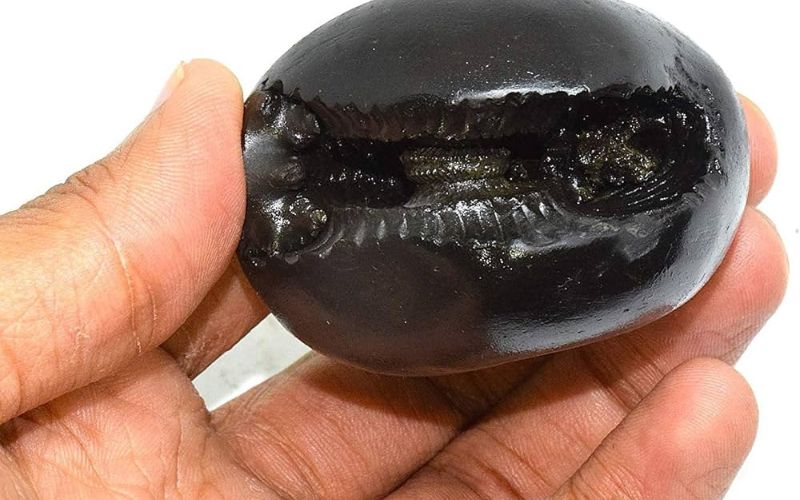Shaligram stones are ancient, sacred fossils found in the Kali Gandaki River in Nepal. These unique, ammonite-like stones are revered in Hinduism for their spiritual significance and are believed to be the physical manifestation of Lord Vishnu. Shaligram stones come in a variety of shapes, sizes, and markings, each with its own unique characteristics and symbolic meaning.
Shaligram stones have been an integral part of Hindu spiritual practices for centuries, used in puja rituals, meditation, and personal devotion. These sacred stones are highly sought after by devotees and collectors alike, with the rarest and most auspicious varieties commanding premium prices in the Indian market.
Significance and Spiritual Beliefs Associated with Shaligram Stones
Shaligram stones are believed to possess immense spiritual power and are considered to be living deities in Hindu tradition. They are associated with various aspects of Lord Vishnu, including his different incarnations and divine attributes. The intricate markings and formations on the stones are said to represent specific iconographic elements, such as the Shankha (conch shell), Chakra (discus), and Padma (lotus).
Hindus believe that owning and worshipping a Shaligram stone can bring about blessings, protection, and spiritual enlightenment. The stones are often used in rituals, mantras, and daily puja offerings to connect with the divine energy of Lord Vishnu. Many devotees consider the Shaligram stone to be a powerful tool for spiritual growth and personal transformation.
Understanding the Different Types of Shaligram Stones
Shaligram stones come in a wide variety of shapes, sizes, and markings, each with its own unique characteristics and symbolic meaning. Some of the most common types of Shaligram stones include:
- Saligram Shila: The most common and widely available type of Shaligram, characterized by its black or dark gray color and the presence of a single Chakra (discus) marking.
- Nila Saligram: A rare and highly prized variety of Shaligram, distinguished by its deep blue or indigo hue and the presence of multiple Chakra markings.
- Suka Saligram: A Shaligram stone with a distinctive green color, often associated with the Suka (parrot) incarnation of Lord Vishnu.
- Padma Saligram: A Shaligram stone with a lotus-like marking, representing the Padma (lotus) symbol and the divine consort of Lord Vishnu, Goddess Lakshmi.
- Shankha Saligram: A Shaligram stone with a Shankha (conch shell) marking, symbolizing the divine sound and the power of Lord Vishnu’s voice.
The rarity and perceived spiritual significance of each type of Shaligram stone can greatly influence its market value and price.
Factors that Determine the Price of Shaligram Stones
The price of Shaligram stones can vary significantly, depending on a variety of factors. Some of the key factors that influence the cost of these sacred fossils include:
- Rarity and Uniqueness: The more rare and unique the Shaligram stone, the higher its price. Stones with distinctive markings, rare colors, or unusual formations are highly sought after and can command premium prices.
- Size and Weight: Larger Shaligram stones, particularly those with a significant weight, are generally more valuable than smaller or lighter specimens.
- Spiritual Significance: The perceived spiritual significance and symbolic meaning of the Shaligram stone can greatly impact its price. Stones associated with specific incarnations or divine attributes of Lord Vishnu are often more valuable.
- Authenticity and Provenance: Ensuring the authenticity and provenance of a Shaligram stone is crucial, as there are many counterfeit or imitation stones in the market. Stones with a verifiable origin and certification from reputable dealers can fetch higher prices.
- Condition and Preservation: The overall condition and preservation of the Shaligram stone, including any cracks, chips, or signs of wear, can affect its value. Well-preserved stones in pristine condition are generally more valuable.
- Demand and Market Trends: The fluctuating demand for Shaligram stones, as well as broader market trends and economic factors, can influence their pricing in the Indian market.
Where to Buy Original Shaligram Stones in India
Acquiring genuine, original Shaligram stones in India can be a challenging task, as the market is flooded with imitations and counterfeit products. However, there are several reputable sources and trusted dealers where you can purchase authentic Shaligram stones:
- Authorized Dealers and Retailers: Look for authorized dealers and retailers who specialize in selling genuine Shaligram stones. These vendors often have established reputations and can provide certificates of authenticity.
- Hindu Temples and Ashrams: Many Hindu temples and ashrams in India, particularly those located near the Kali Gandaki River in Nepal, are known to sell original Shaligram stones to devotees.
- Online Marketplaces: While exercising caution, you can also find genuine Shaligram stones on reputable online marketplaces and e-commerce platforms, as long as you purchase from verified and trusted sellers.
- Direct Imports from Nepal: Some specialized dealers and importers in India may offer direct access to Shaligram stones sourced directly from the Kali Gandaki River in Nepal, ensuring their authenticity.
Regardless of the source, it is crucial to thoroughly inspect the Shaligram stone, ask for relevant documentation, and ensure its authenticity before making a purchase.
Tips for Evaluating the Authenticity of Shaligram Stones
Identifying genuine Shaligram stones can be a challenging task, as the market is flooded with imitations and counterfeit products. Here are some tips to help you evaluate the authenticity of a Shaligram stone:
- Inspect the Markings: Examine the stone closely to ensure that the markings and formations are consistent with the characteristics of a genuine Shaligram. Look for the presence of distinct Chakra, Shankha, or Padma symbols.
- Check the Color and Texture: Authentic Shaligram stones typically have a distinct black, dark gray, or blue-green color, with a smooth, polished texture. Avoid stones with an unnatural or uniform color.
- Look for Imperfections: Genuine Shaligram stones often have slight imperfections, cracks, or natural variations in their appearance, as they are found in the wild. Stones that appear too perfect or uniform may be imitations.
- Verify the Origin: Ensure that the Shaligram stone is sourced from the Kali Gandaki River in Nepal, as this is the only known location where these sacred fossils are found.
- Demand Documentation: Reputable dealers should be able to provide certificates of authenticity, along with detailed information about the stone’s provenance and characteristics.
- Consult with Experts: If you are unsure about the authenticity of a Shaligram stone, consider seeking the advice of experienced dealers, temple priests, or other experts in the field.
By following these tips and exercising due diligence, you can increase your chances of acquiring a genuine, original Shaligram stone.
Average Price Range of Shaligram Stones in India
The price of Shaligram stones in India can vary significantly, depending on the factors discussed earlier. However, as a general guideline, you can expect the following price ranges:
- Common Saligram Shila: Typically ranging from ₹1,000 to ₹10,000, depending on size and quality.
- Nila Saligram: Highly prized and can range from ₹10,000 to ₹1,00,000 or more, depending on rarity and unique characteristics.
- Suka Saligram: Ranging from ₹5,000 to ₹50,000, depending on size, color, and markings.
- Padma Saligram: Priced between ₹5,000 to ₹50,000, depending on the clarity and prominence of the Padma (lotus) marking.
- Shankha Saligram: Valued between ₹5,000 to ₹50,000, based on the distinctiveness of the Shankha (conch shell) marking.
It’s important to note that these price ranges are approximate and can vary significantly based on the specific characteristics and market demand for the Shaligram stone. Rare and highly sought-after specimens may fetch much higher prices in the Indian market.
Benefits of Owning a Shaligram Stone
Owning a Shaligram stone is believed to bring a variety of spiritual and personal benefits to the devotee. Some of the key benefits associated with Shaligram stones include:
- Spiritual Enlightenment: Shaligram stones are considered to be physical manifestations of Lord Vishnu, and worshipping them is believed to foster spiritual growth, inner peace, and a deeper connection with the divine.
- Protection and Blessings: Hindus believe that Shaligram stones can provide protection, remove obstacles, and bestow blessings upon the owner, both in the material and spiritual realms.
- Improved Health and Well-being: Shaligram stones are often associated with healing properties and are believed to have a positive impact on the physical, mental, and emotional well-being of the owner.
- Increased Prosperity and Abundance: Owning a Shaligram stone is thought to attract wealth, abundance, and financial prosperity, as well as facilitate the fulfillment of one’s desires and aspirations.
- Strengthening of Relationships: Shaligram stones are believed to have the power to strengthen familial bonds, improve interpersonal relationships, and foster harmony in the owner’s life.
By incorporating a Shaligram stone into your spiritual practices and daily life, you can tap into the profound energy and blessings associated with these sacred fossils.
How to Care for and Cleanse Your Shaligram Stone
Proper care and maintenance are essential to ensure the longevity and continued spiritual potency of your Shaligram stone. Here are some tips for caring for and cleaning your Shaligram stone:
- Gentle Cleaning: Regularly clean your Shaligram stone with a soft, damp cloth, avoiding the use of harsh chemicals or abrasives that could damage the stone.
- Ritual Cleansing: Perform periodic ritual cleansing of your Shaligram stone, such as immersing it in holy Ganges water or exposing it to the light of the sun or moon.
- Proper Storage: Keep your Shaligram stone in a safe, secure place, away from direct sunlight or moisture. Consider storing it in a dedicated pouch or box to protect it.
- Regular Puja and Offerings: Engage in regular puja rituals and make offerings to your Shaligram stone, such as flowers, incense, or sanctified water, to maintain its spiritual potency.
- Energetic Cleansing: Utilize techniques like meditation, mantra recitation, or the use of sacred herbs to cleanse the energetic field of your Shaligram stone and remove any negative or stagnant energies.
By following these care and cleansing practices, you can ensure that your Shaligram stone remains a powerful and effective tool for your spiritual journey.
Conclusion
Shaligram stones are truly remarkable and sacred objects, deeply rooted in the spiritual traditions of Hinduism. These ancient fossils, found in the Kali Gandaki River in Nepal, are revered for their unique characteristics, symbolic meanings, and the profound spiritual power they are believed to possess.
Acquiring an original Shaligram stone can be a transformative experience, providing the owner with a direct connection to the divine energy of Lord Vishnu. Whether used in puja rituals, meditation, or personal devotion, these sacred stones have the potential to unlock profound spiritual insights, bestow blessings, and facilitate personal growth and transformation.
As you embark on your journey of acquiring and caring for a Shaligram stone, remember to approach the process with reverence, diligence, and a deep understanding of their spiritual significance. By honoring the authenticity and uniqueness of these sacred fossils, you can unlock the full potential of Shaligram stones and integrate them into your spiritual practices in a meaningful and enriching way.
Discover the transformative power of original Shaligram stones and explore our curated collection to find the perfect stone for your spiritual journey. Contact our team of experts today to learn more about the benefits of owning a Shaligram stone and how to properly care for and cleanse it.



